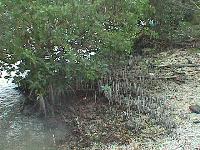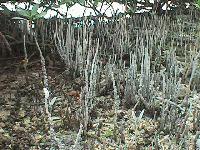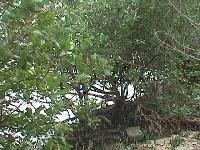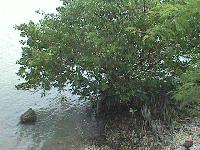

Black Mangroves (Avicennia germinans)


Black Mangrove trees with their roots, pneumatophores exposed.
In the Keys, the black or honey mangrove usually forms a zone behind that of the red mangrove. This tree takes its name from its dark scaly bark. Black mangroves usually grow in soils that are exposed to the air at low tide but covered by high tide. Where they seldom experience frost, as in the Keys, black mangroves can develop into large trees over 50 feet tall. Their 2 to 4 inch long leaves are dark green above with silvery, hairy undersides. In these leaves there are special glands that excrete salt extracted from the water taken in by the roots. The salt often forms a white crust-like coating on their upper surface. Black mangroves have small white flowers which produce abundant nectar used by bees. They have no prop roots, but their root system produces many slender upright aerating roots known as pneumatophores. They cover the muddy soil around the base of the tree and supply the root system with oxygen.
Black mangrove seeds are the size and shape of very large lima beans. They germinate as soon as they fall into the water. The seedlings are smaller than the red mangrove seedlings so they are washed farther up into the forest by tides. Here they become entangled in mats of detritus trapped by the mangrove roots and begin to grow.

